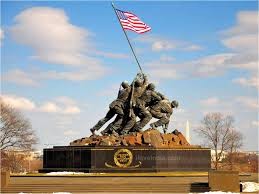U.S. Marine Corps War Memorial
Introduction
Text-to-speech Audio
Dedicated by President and former Allied Commander Dwight D. Eisenhower in 1954, the US Marine Corps War Memorial is based on one of the most iconic images in American military history. The memorial depicts six men raising the American flag over the island of Iwo Jima as a sign that the Marines had won control of that strategic island after a long-fought battle. The American victory and control of Iwo Jima gave U.S. forces control of an island and airfields that was within striking distance of Japan, a feat that demonstrated that the nearly three-year-long struggle in the Pacific was finally coming to a close.
Images
The US Marine Corp Memorial

A picture taken during the Sunset Parade

Backstory and Context
Text-to-speech Audio
Japan began to capture a number of islands throughout the Pacific in the early years of World War Two to maintain control of oil and other resources they needed. Each island served as a buffer against the United States so that they could build their fighting forces to a level that would match the United States. On December 7, 1941, the Japanese attacked Pearl Harbor in Oahu, Hawaii. The U.S. Navy's main fleet survived the ill-fated attack because it was at sea during the raid. A retaliatory attack against Japan was ordered by U.S. officials. Subsequently, U.S. forces began to recapture each island that the Japanese had taken and by 1945 were poised to take the island of Iwo Jima as a staging ground for an assault against the Japanese mainland.
On February 19, 1945, following an ineffective bombing campaign, the United States Marine Corps invaded the island of Iwo Jima. U.S. Marines surrounded Mount Suribachi on Iwo Jima and climbed to the top to take control of the island in less than four days. On February 23, a small flag was raised at the top of the volcanic mountain. Many of the soldiers could not see the small flag, six Marines raided a second, much larger flag. The Marines were Michael Strank, Harlon Block, Frank Sousley, Ira Hayes, Rene Gagnon, and Harold Shultz. Strank, Block, and Sousley would die less than a month after the flag raising.
The surviving three Marines toured the nation, rallying support and advertising war bond when they made it home. Because of the tour, the Seventh War Loan Drive raised over $26.3 million for the war.
It was believed that the sixth soldier was Navy Corpsman, John Bradley. Harold Shultz was misidentified until 2016 and was never publicly identified. John Bradley is now known to have taken part in the first flag raising. Bradley's son, James Bradley, wrote a book about his father's role in the flag raising called Flag of Our Fathers, and later a movie was made with the same title.
President Eisenhower presided over the dedication of the memorial on November 10, 1954. This date was chosen for its symbolism as the 179th anniversary of the founding of the U.S. Marine Corps. The memorial is situated near the Lincoln Memorial, the Washington Memorial, and the U.S. Capitol on the National Mall. Beginning in the spring of each year and running through mid-August, musical and marching units from Marine Barracks honor their fellow Marines during Sunset Parades, which take place on the lawn adjacent to the memorial.
On February 19, 1945, following an ineffective bombing campaign, the United States Marine Corps invaded the island of Iwo Jima. U.S. Marines surrounded Mount Suribachi on Iwo Jima and climbed to the top to take control of the island in less than four days. On February 23, a small flag was raised at the top of the volcanic mountain. Many of the soldiers could not see the small flag, six Marines raided a second, much larger flag. The Marines were Michael Strank, Harlon Block, Frank Sousley, Ira Hayes, Rene Gagnon, and Harold Shultz. Strank, Block, and Sousley would die less than a month after the flag raising.
The surviving three Marines toured the nation, rallying support and advertising war bond when they made it home. Because of the tour, the Seventh War Loan Drive raised over $26.3 million for the war.
It was believed that the sixth soldier was Navy Corpsman, John Bradley. Harold Shultz was misidentified until 2016 and was never publicly identified. John Bradley is now known to have taken part in the first flag raising. Bradley's son, James Bradley, wrote a book about his father's role in the flag raising called Flag of Our Fathers, and later a movie was made with the same title.
President Eisenhower presided over the dedication of the memorial on November 10, 1954. This date was chosen for its symbolism as the 179th anniversary of the founding of the U.S. Marine Corps. The memorial is situated near the Lincoln Memorial, the Washington Memorial, and the U.S. Capitol on the National Mall. Beginning in the spring of each year and running through mid-August, musical and marching units from Marine Barracks honor their fellow Marines during Sunset Parades, which take place on the lawn adjacent to the memorial.
Cite This Entry
Kirwan, Joshua et. al. "U.S. Marine Corps War Memorial." Clio: Your Guide to History. April 14, 2019. Accessed March 21, 2025. https://theclio.com/tour/106/1/reverse
Sources
Marine Barracks Washington, D.C. (n.d.). Retrieved October 27, 2014, from http://www.barracks.marines.mil/Parades/SunsetParade.aspx
US Marine Corps War Memorial. (n.d.). Retrieved October 27, 2014, from http://www.nps.gov/gwmp/historyculture/usmcwarmemorial.htm
Marine Corps War Memorial. (n.d.). Retrieved October 27, 2014, from http://www.marinemarathon.com/MCM_Vault/Marine_Corps_War_Memorial.htmKramer, Gabrielle. Who Were the Marines Who Raised the Flag On Iwo Jima. www.historyhit.com. June 22, 2018. Accessed February 06, 2019. https://www.historyhit.com/marines-iwo-jima/.

